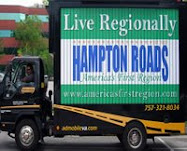This week is National Transportation Week, which provides us an opportunity to reflect on the significant role the Hampton Roads region plays in our nation’s freight network. In 2008, the amount of freight moved through the Port of Virginia increased nearly 50% over the last decade. The port handled over two million TEUs in 2008, but the future appears even brighter-- APM Terminals can double the existing cargo capacity of the region, and Phase I of Craney Island will add an additional capacity of 1.5 million TEUs by 2020.
View this presentation in a new browser window; click on "Full" to view full screen; click on "Download" to download the presentation to your own computer.
The region’s foresight in developing and supporting these critical transportation assets is vital to Virginia economic well-being, and cements Hampton Roads position as the prime beneficiary of the Panama Canal Expansion Project. When the project is completed in 2014, the canal will accommodate significantly larger vessels (up to 12,000 TEUs), and Hampton Roads will be home to the only ports on the East Coast than can handle these size ships.
But in order to move these goods from the ports to their final destination without overloading the region’s already choked highway system, Hampton Roads requires vibrant and efficient rail connections.
To that end, CSX has proposed the National Gateway, a public-private partnership which will create a state-of-the-art rail corridor linking Virginia’s international ports and population centers with the Midwest’s manufacturing centers through use of double-stack trains.
The National Gateway utilizes unlocks a second competitive double-stack route between Virginia and the Midwest and Southeast—additional rail capacity that will be essential to handle the increased freight volumes of the future and will prove critical to the ensuring the ports’ –and the Hampton Roads region’s--long term growth.
View this presentation in a new browser window; click on "Full" to view full screen; click on "Download" to download the presentation to your own computer.
The National Gateway will bring new construction jobs to our state and help businesses in Virginia be more competitive in the global economy. All told, Virginia will realize over $1.2 billion in public benefits from the National Gateway, including:
- Highway Relief: By creating an additional freight transportation option, the National Gateway will reduce traffic congestion and lower highway maintenance costs. One train can carry the load of more than 280 trucks, clearing space for over 1,100 cars. The National Gateway will shift the freight of nearly 5 million trucks off Virginia’s highways, thereby improving road safety and saving $106 million in highway maintenance costs.
- Environmental Benefits: Railroads are the most environmentally-friendly way to move goods on land. On average, railroads are three or more times more fuel efficient than alternatives. The National Gateway will use state-of-the-art green technology and improve the flow of freight by rail in Virginia, reducing fuel consumption by 58 million gallons and CO2 emissions by over 650,000 tons.
- Logistics Savings: By expanding rail access and providing new shipping options, the National Gateway is expected to reduce overall freight shipping costs on goods entering and leaving Virginia by over $690 million.
So as we reflect this week on the integral position Virginia’s ports hold in our nation’s transportation system and the role they have played in the evolution of Hampton Roads, we should also look to ensuring future public policy decisions that will promote continued progress. Taxpayers and businesses should encourage their representatives to support deserving projects such as the National Gateway that will combine state and federal funds with private investment to stimulate our economy, reduce congestion, improve the environment and move the nation forward.
For more information or to support the effort, please visit www.NationalGateway.org.































No comments:
Post a Comment